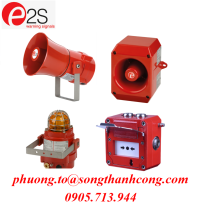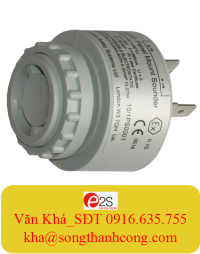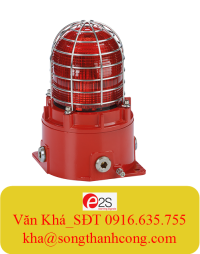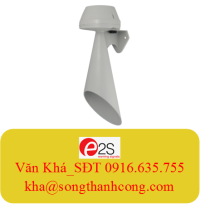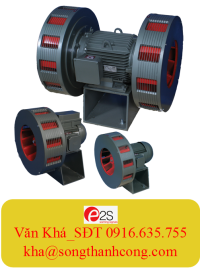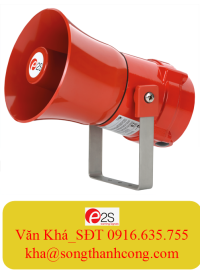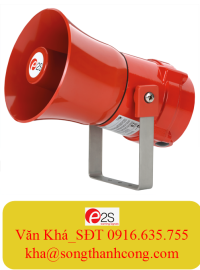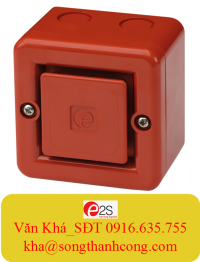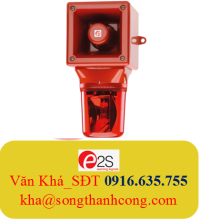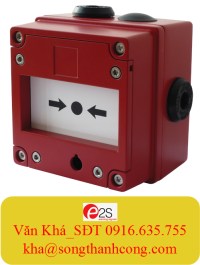.png)
E2S sản xuất một loạt còi báo động hoặc âm thanh phù hợp cho nhiều ứng dụng. Hiệu quả của bất kỳ thiết bị báo hiệu âm thanh nào phụ thuộc vào: kích thước và / hoặc khoảng cách của khu vực được bao phủ, tiếng ồn nền và mô hình & tần số của âm thanh
Làm cách nào để tính khoảng cách ảnh hưởng và phạm vi phủ sóng của thiết bị báo động?
Âm thanh giảm dần khi người nghe cách xa từ nguồn âm thanh, chủ yếu là do sự phân kỳ. Cường độ giảm vì năng lượng được trải rộng trên một diện tích lớn hơn. Nó giảm tỷ lệ nghịch với bình phương khoảng cách từ nguồn âm với tốc độ 6dB cho mỗi lần nhân đôi khoảng cách. Vì vậy, âm thanh phát ra từ một báo động được đánh giá ở mức 106dBA) sẽ truyền đi gấp đôi so với âm thanh được đánh giá ở mức 100dB (A). Nếu một âm thanh được đánh giá ở mức 100dB (A) ở 1 mét, thì ở hai mét, nó sẽ là 94dB (A), ở 4 mét, nó sẽ là 88dB (A), v.v.
| Khoảng Cách(metres) | Độ giảm(dB(A)) |
| 1 | 0 |
| 2 (1m doubled) | -6 |
| 4 (2m doubled) | -12 |
| 8 | -18 |
| 16 | -24 |
| 32 | -30 |
| 64 | -36 |
| 128 | -42 |
| 256 | -48 |
| 512 | -54 |

Tiếng ồn xung quanh ảnh hưởng như thế nào đến hiệu quả của âm thanh
Note: Khoảng cách ảnh hưởng của âm thanh là khi dB (A) được tính toán đạt ít nhất 5dB (A) trên mức nhiễu nền xung quanh đã biết. Ví dụ, khoảng cách ảnh hưởng của âm thanh 100dB(A)@1 met, Đội ồn của môi trường xung quanh là 65dB(A) là mức độ âm thanh giảm xuống còn 70 dB(A) i.e. 100 dB – 30 dB = 70dB. Từ bảng trên (và sử dụng quy tắc bình phương nghịch đảo) giảm 30 dB có nghĩa là âm thanh có khoảng cách 70dB hiệu quả là 32 mét.
Một âm thanh 120dB (A) @ 1 mét có khoảng cách 70dB xấp xỉ 300 mét, tức là gấp mười lần khoảng cách hiệu quả và quan trọng hơn là 100 lần diện tích phủ sóng.
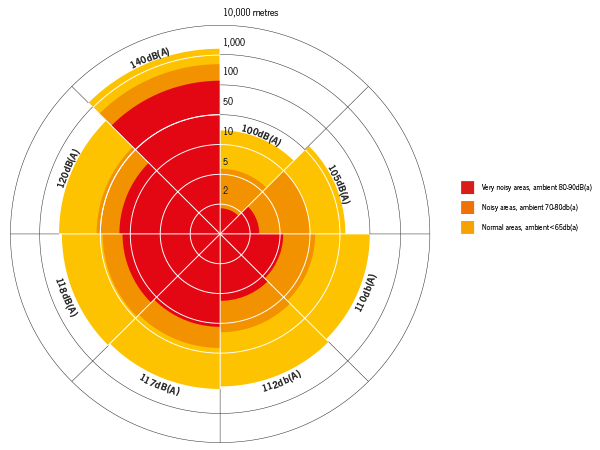
Remember
- In the open, sound will spread in all directions. In an enclosed space some of the sound will be reflected and increase the sound level.
- All-mounted sounder is positioned near a ceiling, more sound will be reflected. The same is true for a ceiling mounted sounder near a wall.
- A sounder mounted on a wall is more effective than one mounted on a pillar.
- Sounders should be sited to avoid immediate obstacles, ideally at a height of approx. 2 to 2.5 metres.
- Synchronized sounders will give a more effective overall effect.
- Personnel may be wearing ear protection.
Sound Output Attenuation: Frequency and Tone Pattern
Sound output is also affected by the frequency of the sound. Lower frequencies tend to travel further, penetrate structures better and are less likely to be attenuated by obstructions. A further adjustment to the range of a sounder may be made according to the frequency of the tone as shown below.
| Frequency of sounder | Adjustment |
| Up to 500Hz | 0dBA |
| 500Hz to 1000Hz | -3dBA |
| 1000Hz to 2000Hz |
-5dBA
|
However
Perception of a tone is not entirely dependent on frequency and sound level. An output with differing frequencies and/or temporal pattern will have a more distinct sound. This can be useful in areas of background noise where hearing protection may be worn. Usually two-tone frequencies, intermittent, ramp-up frequencies or ramp-down frequencies are the most effective.
How many Sounders do I need?
When the area to be covered is large and / or noisy, designers often add more sounders. This could lead to an inadequate coverage, if the alarm sounders were positioned incorrectly or require the addition of more sounders to achieve the bare minimum alarm level.
Example:
Question: A 30m by 20m room, with very little background noise (approx. 65dB(A)), is satisfactorily covered by a 100dB(A) sounder with a 70dB(A) range of approximately 30m. How many sounders would you need if heavy machinery meant the background noise was 85dB(A)?
Answer: One! If the background noise increases by 20dB, install a sounder 20dB louder i.e. a sounder rated at 120dB(A). This simple principle is often forgotten in the need to cover large and noisy areas.
The effective distance of a 100 dB(A) sounder in a very noisy environment is 1.8m, the distance for a 120 dB(A) sounder is approx 18m (10 times the distance).
Note: Alarm sounders that are too loud may be dangerous and cause panic, discomfort and make communication very difficult. As guidance, the overall alarm level should be a maximum of 10 to 15 dB(A) over the ambient background noise.
To achieve 90bB(A) in an area 50 × 30m

Either fit eighty A100 (100dB(A) at 1m) units or fit just two A121 (121dB(A) at 1m) units
More Design Considerations
Sounders aren’t generally effective at an output lower than 65 to 70dB(A) or less than 5dB above the ambient, background noise. Additional sounders or louder sounders may be necessary after calculating the maximum distance and coverage required. Any adjustment according to the output frequency should also be factored in.
Internal fire doors attenuate sound by at least 30dB, and normal doors at least 20dB. It’s advisable that any sounder isn’t required to be heard through more than one partition.

In the above example;
The attenuation caused by distance d1, the door & partition and distance d2 must be calculated (with an adjustment for tone frequency). The final dB(A) level should be not less than 65 to 70dB(A) or not less than 5dB above the background level in area 2.
Care should be taken not to use a sounder with too higher output in area 1 simply to achieve an acceptable level in area 2 as this may make levels in area 1, particularly close to the sounder, unacceptably loud.
Sound Output of Multiple Sounders
Two sounders together with an equal output increases the total output by 3dB. So two 100 dB(A) sounders together will provide 103dB(A) total.
Four 100dB(A) sounders will deliver 106dB(A) in total. It’s important to establish the most suitable sounder at the design stage as simply adding more of the same sounders may only increase an overall alarm level by a few dB.
Disaster warning / Wide area signaling
Large sounders with high outputs of typically 140dB(A) and above have additional considerations such as:
- Attenuation caused by ground effects, barriers such as buildings
- Vertical temperature gradients
- Atmospheric refraction
- Sound absorption in the atmosphere
- People’s perception
- Building construction
It is important to realise predicting coverage can only be an estimate. A combination of these factors attenuating sound in the atmosphere, is both complicated and unpredictable.
Strong winds will influence the effectiveness of the sound coverage. It will tend to make the sound travel further in the direction it is blowing, i.e. in the same direction as gas will be blown in the event of a leak.
In general, disaster warning sounders should be mounted horizontally 10 to 15 metres above the ground, preferably at the highest point on the site to be covered (although not so high that the sound travels over the top of the area). As a general guide, take the height of any obstruction within 50m and keep the sounder at least 2m higher than this for best sound coverage – ideally the source to target should be aimed or “line of sight”.
Choose your application below to view suitable audible signals:
Hazardous area:
Fire & Industrial:
Wide area / disaster / mass notification:
Alternatively, for more information, please contact us.







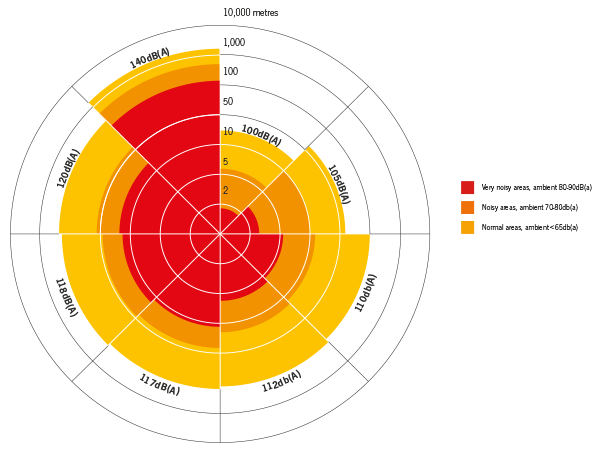
 Mr Vương
Mr Vương live:.cid.d22573c25f91d309
live:.cid.d22573c25f91d309
